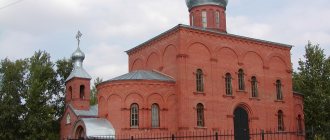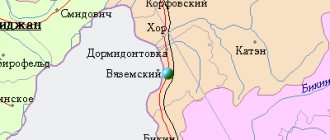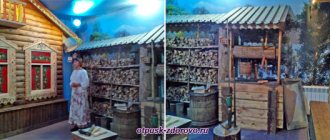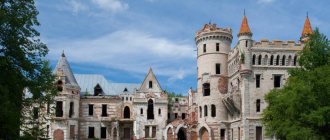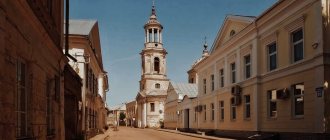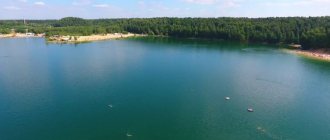Sudogda
(Vladimir region)
OKATO code:
17252501
Founded:
beginning.
17th century City since:
1778 City of district subordination (Sudogodsky district, Vladimir region)
Center:
Sudogodsky district
Telephone code (reference phone)
| 49235***** | 21-3-94 |
Deviation from Moscow time, hours:
0
Geographic latitude:
55°57′
Geographic longitude:
40°52′
Altitude above sea level, meters:
100 Sunrise and sunset times in the city of Sudogda
Private advertisements in Sudogda, in the Vladimir region and in Russia
To add an advert
Vladimir
Promotion With a discount ultrasonic smas Lifting smas lifting on the device ...
Vladimir
Custom-made furniture according to individual sizes
Vladimir
Free premises, 500 m²
Vladimir
Cargo transportation in Russia.
Logistics dispatcher. 123ru.net
- minute-by-minute news with a daily archive. Only here we have all the main news of the day without political censorship. “123 News” - absolutely all points of view, sober analysis, civilized debates and discussions without mutual accusations and insults. If you don’t like it, don’t want to hear it, don’t read it, read it, be mutually polite and correct in your statements. Remember that not everyone's point of view coincides with yours. Respect the opinions of others, even if you defend your views and your position. 123ru.net is a news observer. We do not impose our vision on you, we give you a snapshot of the events of the day without censorship and without cuts. News as it is—online with minute-by-minute archives for all cities and regions of Russia, Ukraine, Belarus and Abkhazia. 123ru.net - live news live! A quick search from 123ru.net is not only the opportunity to be the first to know, but also the advantage of reporting breaking news instantly in any language in the world and being heard right away. You can add your news at any moment - here.
Map
| Sudogda: maps |
Sudogda: photo from space (Google Maps) Sudogda: photo from space (Microsoft Virtual Earth)
| Sudogda. Nearest cities. Distances in km. on the map (in brackets along roads) + direction. Using the hyperlink in the distance , you can get the route (information courtesy of the AutoTransInfo website) | |||
| 1 | Rainbow | 33 (56) | Z |
| 2 | Vladimir | 34 (38) | NW |
| 3 | Gus-Khrustalny | 39 (49) | YU |
| 4 | Melekhovo | 44 (110) | NE |
| 5 | Kameshkovo | 45 (88) | WITH |
| 6 | Kovrov | 53 (121) | NE |
| 7 | Sobinka | 53 (68) | Z |
| 8 | Stavrovo | 56 (65) | Z |
| 9 | Red Gorbatka | 56 (85) | IN |
| 10 | Lakinsk | 57 (64) | Z |
| 11 | Kurlovo | 57 (70) | YU |
| 12 | Suzdal | 60 (75) | NW |
| 13 | Roshal | 69 (228) | SW |
| 14 | Nikologory | 73 () | IN |
| 15 | Savino (Ivanovo region) | 74 (164) | WITH |
| 16 | Kosteryovo | 77 (93) | Z |
| 17 | Mstera | 81 (173) | NE |
| 18 | Gavrilov Posad | 82 (101) | NW |
| 19 | Melenki | 83 (134) | SE |
| 20 | Moore | 84 (93) | SE |
| 21 | Vyazniki | 86 (152) | IN |
| 22 | Cockerels | 87 (100) | Z |
| 23 | Tuma (Ryazan region) | 91 (110) | YU |
| 24 | Lezhnevo (Ivanovo region) | 92 (129) | WITH |
| 25 | Shatura | 93 (198) | SW |
| 26 | Yuriev-Polsky | 95 (107) | NW |
| 27 | Navashino | 95 (109) | SE |
| 28 | Doschatoe (Nizhny Novgorod region) | 98 () | SE |
| 29 | Kolchugino | 99 (110) | NW |
| 30 | Spas-Klepiki | 100 (135) | SW |
| 31 | Yuzha | 100 (217) | NE |
a brief description of
The city is located on the Meshcherskaya lowland, on the left bank of the river. Sudogda (tributary of the Klyazma), 6 km from the railway of the same name. station, 40 km southeast of Vladimir.
Territory (sq. km): 12
Information about the city of Sudogda on the Russian Wikipedia site
Historical sketch
Mentioned in documents from the early 17th century. like Sudogodskaya Settlement, which belonged to Prince M. Gryazev. Later the village of Sudogda. Name by location on the river. Sudogda (right tributary of the Klyazma). The hydronym is typical for the pre-Russian hydronymy of the North: the stem Sud- and formant-ogda are repeatedly found in hydronyms of Finno-Ugric origin.
Since 1778, the district town of the Vladimir governorship (since 1796 - Vladimir province), since 1803 - a provincial town, since 1803 a district town. In the 19th century carried out primarily administrative functions.
In 1806 and 1838 seriously damaged by fires. In 1856, in the district town of Sudogda, Vladimir province, there were 2 churches, 229 houses, 9 shops.
At the end of the 19th century. in Sudogda there was a flax spinning factory (up to 1 thousand workers) and a bottle and glass factory. Men's and women's city schools were opened.
Economy
The leading enterprise of Sudogda is JSC Krasny Khimik (fiberglass production). Factories: flax spinning (bags) and sewing. Furniture manufacture.
Potatoes and grain crops are grown in the Sudogodsky district. They raise cattle and poultry.
Limestone deposits.
Main enterprises
CHEMICAL INDUSTRY
OJSC "Sudogodskoe fiberglass"
601240, Vladimir region, Sudogodsky district, Sudogda, st.
Kommunisticheskaya, 1 Offers:
glass beads, fiberglass, fiberglass, basalt fabrics
| Population by year (thousands of inhabitants) | |||||||
| 1856 | 2.5 | 1979 | 12.4 | 2006 | 12.7 | 2016 | 10.7 |
| 1897 | 3.2 | 1989 | 14.2 | 2007 | 12.5 | 2017 | 10.5 |
| 1913 | 4.1 | 1992 | 14.6 | 2008 | 12.4 | 2018 | 10.4 |
| 1923 | 3.5 | 1996 | 14.7 | 2010 | 12.0 | 2019 | 10.3 |
| 1926 | 4.1 | 1998 | 14.6 | 2011 | 11.8 | 2020 | 10.1 |
| 1931 | 4.4 | 2000 | 14.5 | 2012 | 11.6 | 2021 | 10.0 |
| 1939 | 6.2 | 2001 | 14.5 | 2013 | 11.3 | ||
| 1959 | 7.5 | 2003 | 13.3 | 2014 | 11.0 | ||
| 1970 | 10.5 | 2005 | 12.9 | 2015 | 10.8 | ||
0.8 km. east of the northern outskirts of the city, 1.5 km. Below the bridge on the P-72 highway is a Bronze Age Settlement
. Dune-like hillocks in the floodplain of the right bank of the river. Sudogda, 70 m north of the place where the nameless stream flows into it. The height above the floodplain is 0.6-0.7 m. Thin-walled molded ceramics, with admixtures of fireclay and gruss in clay dough, ornamented with oblique notches, presumably of the Bronze Age, split burnt stones.
Origin of the city's name
The city is named for its location on the Sudogda River. In turn, the hydronym, according to the most common version, is of Finno-Ugric origin. According to it, the hydronym comes from the ancient Finno-Ugric “Sutkeda/Sudgeda” (“Winding”), which actually reflects the topography of the river bed. The name of another river in the Sudogodsky region, Soima (Suoima), comes from the Finno-Ugric “Suoyama” (“Defender”). According to another version, it comes from the Tatar su - water and dogd - around (“there is water all around”, “big water”; accordingly, the name of the Soima River is explained as “small water”).
Geography
It is located 40 km southeast of Vladimir, on the Sudogda River (the right tributary of the Klyazma), 6 km from the railway station of the same name (the terminus on the branch from the Kovrov - Murom line).
Sudogda River
Pedestrian bridge over the river.
Sudogda Historically, Sudogda was located on a large postal route from Vladimir to Murom;
Currently, the P72 highway Vladimir - Murom - Arzamas runs north of the city. SLOBODA SUDOGDA
No written evidence has been preserved about the time of the initial founding of the settlement on the site of the present city of Sudogda, but it is certain that by the beginning.
In the 16th century, a village existed here. The first chronicle mention of Sudogda dates back to 1529. In 1529, the volost village of Sudogda was given by Moscow Prince Vasily III “to feed” the Moscow boyar Karamyshev, who was sent into exile under the guise of strengthening local sovereign power. Karamyshev carried out registration of recruits in the Sudogod lands, collection of taxes and taxes. In 1533, after the death of Vasily III, he returned to the capital. In 1552, the great Tsar Ivan the Terrible passed through Sudogda and Murom to Kazan, and then returned with his warriors in victory. It was in Sudogda that the king received news from a messenger about the birth of his first child from his wife Anastasia. In 1552, it was mentioned as the Yamskaya settlement
with a population of “Finnish origin” (meaning the descendants of the Finno-Ugric tribe of Murom).
In the beginning. In the 17th century, the settlement was the estate of the nobleman Ivan Gryazev. This Gryazev was the Duma clerk of Tsar Mikhail Fedorovich; the Tsar entrusted very important assignments to him. So in 1615, as a clerk, he delivered the royal letter to the English king James, and in 1631 Gryzev was ambassador to the Danish king Christian IV. In 1628, Tsar Mikhail Fedorovich granted this clerk Ivan Gryazev the patrimonial estate of Sudogda with the villages of Ofonina, Ushakova, Stepacheva and Lavrova. In the royal letter, this royal favor is motivated by the fact that clerk Ivan Gryazev pacified the Nogai Murzas near Astrakhan, brought them “under the royal hand”, into citizenship of the Russian Tsar. Under Ivan Gryazev, the Church of St. Nicholas the Wonderworker was built in the settlement of Sudogda. In 1634, clerk Ivan Gryazev died, and the granted estate passed to his wife; in 1640, Gryazev’s wife also died, and the settlement of Sudogda with its villages came into the possession of the Moscow Simonov Monastery, according to Gryazev’s will. In the beginning. XVII century on the river Sudogre there was a church of St. Nicholas the Wonderworker
“on
the old pit
”. According to the census books of the Vladimir district in 1678, in the settlement of Sudogda with the villages of Ofonina, Ushakova, Stepacheva and Lavrova, there were 50 peasant households and 30 bobyl households. In 1764, with the establishment of monastic states, the settlement of Sudogda with its villages came under the jurisdiction of the College of Economy.
CITY OF SUDOGDA
In 1778, by decree of Catherine II. Sudogda became a county town
Sudogodsky district of the Vladimir governorship, on December 31, 1796 turned into a provincial town, on May 24, 1803 it was again appointed
a district city of the Sudogodsky district of the Vladimir province
. Tradition says that Catherine II almost died here. Traveling across Russia, she found herself in the floodplain of Sudogda, where her carriage got stuck, so much so that the crew fell deeper and deeper until they were finally rescued. The Empress was very frightened by what happened and, in memory of the rescue, ordered the construction of a cathedral here at public expense, and gave the residents a number of privileges.
Coat of arms of the city of Sudogda
In 1781, the city's coat of arms appeared; four silver rakes in the lower part of the coat of arms symbolized the main occupation of the Sudogod residents - making hay.
In 1784, the first population census was carried out in the city, according to which 243 people lived in 50 households of Sudogda, of which 126 were men and 117 women. By 1788, a master plan for the development of the city
, according to which it was divided into a grid of rectangular blocks located along the road from Vladimir to Murom.
In 1806, a strong fire destroyed almost all the buildings of the city, including the wooden churches of St. Nicholas the Wonderworker and St. Martyr Mina. In 1814, the stone Catherine Cathedral
, but the second major fire that occurred in 1838 again caused severe damage: the cathedral was burned outside and inside, only some icons, utensils and the sacristy were saved.
The temple was restored and consecrated in 1891. 1838 about the philanthropic action of the merchant Baburin: “The Vladimir Civil Governor recognizes the need to make known through this the commendable and philanthropic action of the Moscow 2nd guild merchant Ivan Baburin, who, out of compassion for the burnt residents of the city, Sudogdy, donated his factory works to their benefit, amounting to more than 2 thousand rubles, such as scarves and chintz. This will be brought to the attention of the Minister of Internal Affairs.” An everyday picture from the era of serfdom in the Vladimir province in 1852. The city of Sudogda in 1861. After the abolition of serfdom in 1861, a large layer of people began to engage in latrine work and various earnings on the side. On Monday, August 11, 1869, a disaster befell the city of Sudogda, ruining more than half of all residents. In the morning, when almost all the residents were in the church for a prayer service on the occasion of lack of rain, a fire broke out in the house of the merchant Lopanov and despite the energetic actions of the police officials and the fire brigade, despite the help provided to them by the workers sent with two fire extinguishing pipes and barrels by the landowner Khrapovitsky and Berezhkovsky volost rule, with a strong wind, the flame spread so quickly that in no more than two hours 146 houses, with all outbuildings and property, burned down. During the fire, the cathedral church and public places were in great danger. The city council and post office burned down. In 1870, a government building and the Alexander Nevsky Church were built in Sudogda, which mainly served as a prison (the district prison was located next to the church). The church owned the prison library
, which was headed by the rector of the church, Fr. Arkady Kolerov (1865-1914), who taught reading and writing to willing (illiterate prisoners). The Sudogda Zemstvo Hospital was built by the zemstvo in 1887 “... the city of Sudogda is currently only the administrative center of the county and is more like a trading village than a city. there are no large commercial and industrial enterprises here, and its population itself is very insignificant for the city: about two and a half thousand men and women” (V.G. Dobronravov. 1897). In 1862, a tannery of merchant Vasily Fedorovich Bezpalov was opened in the city. Sudogwhere. In 1890, a horse drive for 1 horse; 5 workers. In 1870, the tannery of the merchant Egor Leontyevich Bezpalov was opened in the city. Sudogwhere. In 1890, a horse drive for 1 horse; 6 workers. In 1871, the oil mill of candidate of commerce Sergei Ivanovich Shcheglyaev was opened. In 1890, a steam engine, 10 horsepower; steam boiler; 8 workers. In 1879, the city's first flax spinning factory began operations, in August 1897 - a bottle factory, which later became the city's largest enterprise, producing glass containers, and since the 1960s. - fiberglass, fiberglass and fiberglass. Limited Liability Company "Sudogodskie Fiberglass" is an enterprise that continues the traditions of OJSC "Sudogodskie Fiberglass".
Bust of Lenin at
the Annual medical report of the Sudogodsky district for 1911 Agronomic report of the Sudogodsky district for 1911. Stay of Evgeniy, Bishop of Murom, in the city. Sudogde May 24-25, 1911. “On July 22, 1914, after 6 o’clock in the evening, a crowd of demonstrators of about 300 people gathered and, with portraits of the Emperor and Empress, and with national flags, walked along the streets of the city. They sang “God Save the Tsar” and “God Save the Tsar” repeatedly... There were speeches imbued with patriotism; cries were heard: “Long live Russia” and “Long live the Slavic brotherhood”, “Down with Germany”. The exclamations were followed by a friendly “hurray”... A prayer service was served in the open air and the manifesto was read. At the words of the priest, “bend your knees,” the crowd fell on their faces. The demonstration ended late in the evening” (“Murom Region”, July 25, 1914). Sudogodsky district during the First World War.
Map of pre-revolutionary Sudogda
The city of Sudogda in the revolutionary period 1905 – 1918. On February 20, 1921, a ceremonial meeting of the District Bureau of prof. Unions in the newly opened Palace of Labor. In 1923, a theater was opened in the city. “Until now there was not a single theater in the city. Now, thanks to the efforts of the regional committee of the RCP and the executive committee, a theater that is very good for Sudogda has been opened. Now there is a place to relax in your free time and have reasonable entertainment” (“Call,” December 18, 1923). From August 17 to 19, 1924, the district Komsomol Sports Olympics was held. “The other day we started laying the foundation for a monument to Lenin, which is supposed to be rebuilt for the 7th anniversary of the October Revolution. The monument will be erected on the square from where all trade was transferred to another place. The construction of the monument is carried out using contributions from workers and employees” (“Call,” October 23, 1924). “The State Executive Committee found it possible to satisfy the request of the Sudogodsk executive committee to transfer to it a water turbine from the b. Soleinikov. The Civil Commission, however, decided that it was an indispensable condition that the turbine be used exclusively for the purpose of electric lighting of the city" ("Call", November 16, 1924). “Construction of a power plant in the city. Sudogde is nearing its end. In May the city will be partially illuminated. From July the station will be in full swing and, in addition to the city, will provide energy to two more nearby villages: Khoroshevo and Bashevo” (“Call,” April 16, 1925).
«AGITO FLIGHT OF THE AIRCRAFT “ALL TO AVIAHIM” Kovrov—Sudogda—Pereslavl
.
... Sudogda
. It's the same picture. Workers of the Pervomaiskaya factory, residents of Sudogda and peasants from the village of Khoryshevo, closest to the city, gathered at the landing site. The plane is here for the first time! And when he made circles over the place of descent, the crowd of those gathered quickly grew louder and froze, and then gradually began to tighten and perk up... Greetings. And then: - Who wants to receive “baptism”? And again the crowd backed down a little and became quiet. But then two people separated from it. These are May Day people. - We wish. - Who else? The pilot jokes: “With bigger beards.” Young people are still getting better. Enough for her lifetime. Finally, after much persuasion, a peasant from the village of Khoryshevo and a city resident with a large, half-gray beard climb into the cabin of the plane. And when the booth door slams behind them, the peasant says: “Maybe, nothing?!” And on earth after “baptism”: - Notable. And it’s not scary... But the Pervomaiskaya factory seemed no bigger than a fist. Thank you, comrades. I’m going to the village and I’ll tell you... Before departure, the pilot invites the peasant: “Are we going to Vladimir?” - Thank you. If it were tomorrow, I would be happy to. Heading to the market. And today: there is no business in Vladimir...” (“Call”, February 2, 1927).
Educational establishments
Educational institutions of the district mountains. Sudogdy. Educational institutions of Sudogodsky district in 1884
The city of Sudogda, Vladimir province on an old postcard.
Pesochnaya Street Lived on the former Dvoryanskaya Street from 1820 to 1847.
Savelov Ivan Efimovich, Archpriest of Catherine's Cathedral. Intelligent, gifted with eloquence, an extremely selfless and hardworking person. I acquired a lot of information, very diverse and quite thorough. He studied theological subjects in depth, had an excellent command of many languages, and was also a mathematician, painter, and mechanic. But most of all, Savelov remained in the memory of the Sudogod residents as a wonderful doctor and warlock magician. On Pesochnaya Street there stands a small one-story stone house inconspicuously. It was here that the relic was kept - the treasured casket of Arina Rodionovna, in which Nikolai Mikhailovich Yazykov kept Pushkin’s letters and the autograph of the poem “Near the Lukomorye there is a green oak.” The casket was given by Arina Rodionovna to A. S. Pushkin’s friend, the poet Nikolai Mikhailovich Yazykov, who visited them in 1826. This box is rectangular in shape, oak, with cherry wood trim, a hinged lid and a hole for a piggy bank. On the inside of the lid there is a paper sticker, yellowed with time, with a phrase written in Pushkin’s hand: “For a rainy day. This box was made on the 16th day of July 1826.” In it, Nikolai Mikhailovich kept Pushkin’s letters and the autograph of the poem “There is a green oak at the Lukomorye.” This is the only genuine thing of Arina Rodionovna that has survived to this day and is stored in the Mikhailovskoye Museum-Reserve. And Pushkin himself passed through the provincial town of Sudogda. It was in early December 1830, when he was able to leave Boldino for Murom, Vladimir and drive to Moscow, where his angry bride was waiting. Returning from Siberian exile, A. N. Radishchev passed through Sudogda in 1787. He described his long journey through Nizhny Novgorod and Murom in his diary: “Before Sudogda there was sand and treelessness, near Sudogda and after there was forest. We drove through a forest to New Village (now Baraki). Radishchev arrived in Sudogda on June 8. Economy
Currently, the production of fiberglass, roofing materials, structural fabrics, basalt threads is developed at Sudogodskie Plastics OJSC; light industry (flax spinning and clothing factories); furniture manufacturing; food industry (JSC Sudogodsky Dairy Plant). In 1960 - construction of the Experimental Glass Factory (Internatsionalnaya St., 114). 1964 – commissioning of a ceramic workshop, mechanical workshops, and boiler room. 1968 – commissioning of a glass melting furnace. 1977 – production of glasses with thickened bottoms. 1980-2000 – mastering the production of souvenir products, constantly updating the assortment. 2001-2006 – commissioning of new German-made equipment, increasing the volume of products. 2011 – acquisition of a controlling stake in the Pilot Glass Factory by the international corporation ARC International. 2012 – review of all areas of the plant’s work, changes in social policy, introduction of a modern system of quality control and safety in production, launch of products under the Luminarc and Arcoroc brands. 2013 – start of production of blown glass products and stemmed glasses.
A railway line approached the city from Volosataya station on the Kovrov-Murom line. In 2006, it was dismantled at the Nerudnaya - Sudogda section.
Temples of the city
- St. Catherine's Cathedral. — St. Catherine’s Orthodox School in the city of Sudogda. — Temple of the Holy Blessed Prince Alexander Nevsky. — Cemetery church in the name of renovation of the Church of the Resurrection of Christ (not preserved).
Culture, education, sports
— MBUK Sudogodskaya Central District Library. st. Karla Marx, 59/9 In 1888, the Vladimir governor allowed the opening of a reading room at the Sudogodsk district zemstvo government.
Cultural and leisure
- Sudogodsky Museum of Local Lore was opened in 2007. st. Lenina, 65.
"House of Folk Art"
— Municipal cultural institution of the Sudogodsky district “House of Folk Art”. st. Lenina, 10. - The regional socio-political newspaper “Sudogda and Sudogodtsy” is published (founded on April 25, 1931, previously published under the names “Udarnik” and “Leninets”). — Center for extracurricular activities. — Children's hockey club “Sudogodets”. A major event in the life of Sudogod residents is the All-Russian tournament of young hockey players in memory of Alexander Ragulin, held annually during the winter holidays (first organized by the Olympic champion himself in 2002). In 2011, the Sudogda Cross Club organization was created and official motorsport competitions are held.
City layout and attractions
The old part of Sudogda, located on the left bank of the river, has preserved the historically established rectangular grid of streets. On the central street named after Lenin (formerly Bolshaya Ekaterininskaya), buildings of the 19th - early 19th century are of interest. XX centuries, including the house of the founder of the Sudogod glass factory Evgraf Golubev (see merchant dynasty of the Golubevs) and the wooden house of his mother, the buildings of the city fire station and the real school (now school No. 1), the house of the mayor with baroque motifs, the Alexander Temple Nevsky and Catherine's Cathedral. On Krasnaya Street (formerly Dvoryanskaya) the complex of the city estate of the con. has been preserved almost unchanged. XVIII - beginning XIX centuries (now a private house) and a former parish school (built in 1903, now a post office). The construction of other streets of the center and the adjacent microdistricts Khoryshevo and Posadka is low-rise, mostly wooden. Among the local merchants, the first were the Golubevs. They created the trading house “Evgraf Golubev with his sons and grandsons.” They traded colonial goods, textiles, haberdashery, bread, wine, iron, being a supplier to the highest court. On Ekaterininskaya Street they owned four of the best houses.
The city of Sudogda, Vladimir province on an old postcard. Ekaterininskaya street and city garden. “They opened the garden, but they don’t let me go for a walk (Sudogda). A month ago, the board of the Inter-Union Club opened a city garden. They were going to concentrate all the cultural work here, but they never got around to it. The garden is always locked. Not only is there no cultural work carried out there, but even during free time from work they are not allowed to go for a walk” (“Call,” July 8, 1924).
“Golubev’s House”, beginning. XX century.
Ekaterininskaya Street, view of the cathedral before its destruction. Mansion of Peter Kozmich Golubev
Mansion of Peter Kozmich Golubev
The mansion of Pyotr Kozmich Golubev was built in 1916 - a beautiful classical-style building with four columns decorated with stucco, the inside of the building is very rich. The owners did not have time to live in it, later various organizations were located here, and now it stands ownerless and is deteriorating before our eyes... The Golubevs owned a flax spinning factory, which they set up on the banks of the quiet river Sudogda in 1876, and opened it in 1879. Every three years was attached to the main building behind the building. With the import of a powerful steam engine from England in 1891, the factory became a large enterprise; in 1900, 1,200 people worked here. In 1897, a bottle factory was launched, whose products could be seen in Vladimir, Moscow, and St. Petersburg. On the left side of Ekaterininskaya Street, opposite the city court, People's Artist Elena Nikolaevna Gogoleva lived for a short time.
The building of the former City Duma
It was built at the end.
XIX century for the needs of the Sudogodskaya City Duma. The local Assembly of Nobility also met there. City Council
(late 19th century): City mayor - later. honor citizen Kozma Lvovich Golubev. Members: intercession place of the mayor, local. Mina Ivanovich Rybakov; local Egor Leontievich Bezpalov. Taking the place of the chairman according to 120 art. city. positive – count Assess. Ivan Vasilievich Lyubimov. City secretary - governor. secret Andrey Kozmich Piskunov. Accountant - lips. secret Andrey Ivanovich Shigolev. In the building of the City Duma on October 26, 1917, the Provisional Executive Committee was overthrown and power passed into the hands of the Soviets. Nowadays, the old house houses the local history museum, the tax office and the Administration of the city of Sudogdy.
Smirnov's trading store.
1870 Smirnov's trading store
1870 Monument of urban planning and architecture of regional significance.
City fire station
Trading shop
Trading shop
con. XIX - early XX centuries Monument of urban planning and architecture of regional significance.
Children's art school
Historical monument. The first district congress of Soviets took place here on May 25, 1917. The revolutionary M.P. took part in the work of the congress. Yanyshev. Subject to protection as a national property.
"Residential building", con. XIX century
"Residential building", con. XIX century Monument of urban planning and architecture of regional significance.
On December 7, 2009, the first annual city competition “Person of the Year” was held at the Rodina CDC, dedicated to the memory of the famous surgeon, city resident, Honored Doctor of the RSFSR - Alexander Stepanovich Novikov. The competition is held with the aim of activating public self-awareness, educating the younger generation of citizens about citizenship, and organizing public recognition of the merits of city citizens in socially useful activities.
Street Freedom Square
Street Freedom Square
Street Freedom Square
The city of Sudogda, Vladimir province on an old postcard. Ekaterininskaya street
Lenin Street
Lenin Street
On the right bank of the river there are new microdistricts Poyma, Khimik, Stroiteley, Novaya Fabrika, which appeared thanks to the development of the city's largest enterprises - and a textile factory.
Notable residents
- Dubensky Nikolai Yakovlevich (1822–1892) - researcher of the Vladimir province, native of the village. Pyatnitsa–Dubenki, Sudogodsky district. - Jerome (Chernov) (1878-1957) - Archbishop of Detroit and Flint (ROCOR), a native of Sudogda. — Meretskov Kirill Afanasyevich (1897–1968) — organizer of Soviet power in Sudogda, Marshal of the Soviet Union. - Skvortsov Vladimir Andreevich (07/14/1922 -10/13/2008) - graphic artist, member of the Union of Artists of the USSR, native of the village. Moshok, Sudogodsky district. - Vladlen Sirotkin (1933-2005) - historian, Doctor of Historical Sciences. - Ekaterina Gradova (born 1941) - Soviet actress, often comes to Sudogda and lives here for a long time.
Neighborhood
In the village of Muromtsevo (3 km southeast of Sudogda) there is a palace and park ensemble (1884) of the estate of Colonel of the Life Guards V.S. Khrapovitsky (Khrapovitsky Estate in Muromtsevo), designed according to the model of Western European castles. After the revolution, the estate was used as a real school, was subsequently abandoned, survived a fire and until recently was in deplorable condition. Currently, work is underway to restore cultural heritage and monuments. Some buildings are used by the Muromtsevo Forestry Technical School for educational premises. Of particular interest is the park-arboretum, where the count collected trees from different countries, as well as the so-called “dog hill”, where Khrapovitsky’s pack of hunting dogs, which he ordered to be killed after 1917, before emigrating abroad, are buried. Sudogda “Fountain” is a natural “fountain” located in the bed of the Peredel River, not far from Sudogda, Vladimir region.
MONUMENTS, MEMORIALS
During the Great Patriotic War, conscripts of 1941 and those mobilized through Sudogda to Kanash and further to formation points kneaded the autumn mud.
Children of besieged Leningrad and war invalids from German-occupied regions found shelter on Sudogodskaya land. Working life has not stopped. Enterprises switched to producing products for the front. Many Sugogods went to the front. They fought to the death near Brest, courageously defended Leningrad, fought in the forests of the Smolensk region and Belarus, in the vastness of Ukraine, on the outskirts of Moscow. of Heroes of the Soviet Union
are associated with Sudogda and the region : 1. ANDREEV IVAN EFIMOVICH 2. BYAKOV ALEXEY IVANOVICH (1912-1941). 3. KABANOV VASILY GRIGORIEVICH. 4. KABANOV PAVEL ANTONOVICH. 5. KONKOV FEDOR GERASIMOVITCH. 6. MISHULIN VASILY ALEXANDROVICH. 7. OSHMARIN IVAN KONSTANTINOVICH (1920-1943). 8. SAVELIEV ALEXANDER VASILIEVICH. 9. SPIRIN NIKOLAY IVANOVICH In Sudogda, four city streets are named after heroes.
“Eternal memory to the soldiers of the Sudogodsky region who fell in the battles for the independence of our Motherland in 1941-1945.” Victory Park.
A monument symbolizing the numbers of the beginning and end of the war. Monument to WWII participants.
In memory of the courage of the residents of Sudogda and the region shown during the liquidation of the consequences of the disaster at the Chernobyl nuclear power plant and other nuclear facilities. Monument to Chernobyl victims.
Fountain on the street Lenin Bust V.I. Lenin
GLADE OF FAIRY TALES
HISTORY of the Vladimir region Sudogodsky district
↑ Sights of Sudogda
The main attraction of the city is old Sudogda, which is located on the left bank of the river. The historical grid of neighborhoods has been preserved here, signifying competent planning and development. Houses from the 19th and 20th centuries are definitely worth a look for a visitor to the city. In the same part of the city there is the magnificent Alexander Nevsky Temple and Catherine's Cathedral.
On the right bank of the river “there is a new city” with a plant and factories. Three kilometers from Sudogda there is the village of Muromtsevo - the palace and park ensemble of V. S. Khrapovitsky. It is noteworthy that the estate is made in Western style. After the revolution, the premises of the estate were used for the needs of the school, then it burned and was in a deplorable state. Today, restoration and restoration work is underway.
Since 2007, the local history museum has been located in the district administration building. The museum's exhibitions will tell you about the history, life and life of the Sudogodsky district. The “History” exhibition is very interesting. She will talk about the art of local glassmaking.
↑ History of Sudogda
The city owes its name to the river on the banks of which it is located. The first mention of Sudogda appears in documents of the 16th century; in 1552 the town was referred to as a Yamskaya settlement. Later, a century later, a mention of Sudogodskaya Sloboda appears. The land belonged to Ivan Gryazev, and later to the Simonovsky Monastery.
During the Russian Empire, Sudogda changed its administrative status several times. It was either a district town or a provincial town; it belonged to the Vladimir governorship. The city first received county status during the reign of Catherine II.
During the reign of Catherine II, a population census was conducted and a city development plan was approved. The territory was divided into a grid of rectangular blocks stretching along the Vladimir-Murom road.
In 1806, trouble came to the city. A strong fire caused great damage to Sudogda, almost completely destroying it. In 1870, the Alexander Nevsky Church was built in the city. There was a prison next to the temple, so the church became a prison. There was a prison library on its territory. The local clergy taught literacy to prisoners who showed a thirst for knowledge.
At the end of the 19th century, a flax spinning factory and a bottle factory began operating in the city. In Soviet times, the bottle plant received the name “Red Chemist”, and was engaged in the production of such products as: fiberglass, fiberglass, fiberglass and glass containers. In 1996, reorganization began at Krasny Khimik with the aim of optimizing production and automating business processes. The plant split into several production units. The enterprises produce fiberglass and basalt thread.
↑ Where is the city of Sudogda located?
Sudogda is located in the Vladimir region, forty kilometers from the regional capital. The city is located on two rivers. One of them gave the name to the city. From Finno-Ugric, the word in Russian can be interpreted as “winding,” which in principle reflects the essence of the river.
The name of the second river on which the city stands is Soima. There are two versions of the origin of the name, one from the Finno-Ugric Suoyama, the second from the Tatar - su and dogd. In the first case, the name can be translated into Russian as “protector”, in the second – “small water”.
